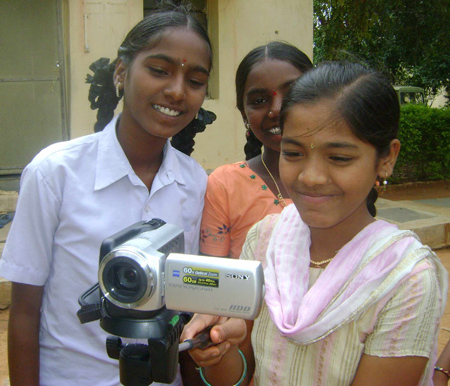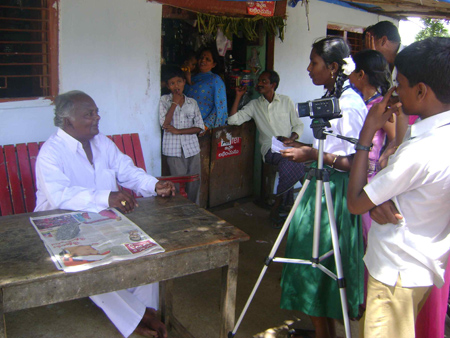"I'm now finishing watching the film and its fantastic! Im really impressed with the clarity and messages coming through as well as with the material. So straightforward and a great design!"
English | Español | ျမန္မာစာ | Беларуская

|
|
English | Español | ျမန္မာစာ | Беларуская |
|
Children As Media Producers
Submitted by ramsey on Tue, 02/01/2011 - 15:43
Should children only be the consumers of information? Should they not also have a voice to be able to tell stories from their own perspectives? These were some of the questions that encouraged a partnership between UNICEF and the Department of Communication, University of Hyderabad to launch CAMP, or Children as Media Producers, a participatory video initiative that took place in the Medak district of Andhra Pradesh, India.
Launched in June 2009, CAMP sees decentralised information and communication structures as an important way of empowering children who have been traditionally marginalised. For effective child participation to take place, facilitation of dialogue among members of the community is important.  Electronic grassrooting' of democracy is seen as a way of helping to construct a new kind of civil society. “Children therefore were provided access to means of communication, training on how to use the technology and helping them to gain an understanding of the how the media works as well as develop their communication skills,” says Vasuki Belavadi, trainer & Associate Professor at the Department of Communication. The children at CAMP, aged 12-16, were selected by the UNICEF supported project, the Behavioral Change Communication Cell (BCC Cell) in Medak, the youth went through a training process including visual grammar, basics of camera, the significance of various shot sizes and their use in producing a film. The children have so far produced over 30 videos some of which have been hosted online. “Since mainstream media don’t report our villages, we chose to learn to make videos,” said Pushpalatha of Ismailkhanpet village. The project wasn’t only about help youth learn the basics of producing a film, but also focused on their ability to highlight issues in their communities and advocate for change. Md. Akram of Doulatabad village said, “People fall ill because the drains aren’t clean. That is why we made films on such problems.” The films created during the program covered a variety of topics effecting children and other community members including farmers and women. “I want to do stories that will bring children’s issues to the attention of the Sarpanch (village head) so he can solve problems,” says Pushpalatha. Teachers of the schools where the children had enrolled were apprehensive about what impact CAMP could have.  “Once they saw our videos, they began encouraging us,” says Mohd. Akram. Parents were also excited when they learnt that their children’s films would be screened at the International Children’s Film Festival, 2009. Farmers’ suicides moved the children so much that they decided to make a film on it. “Agriculture going to seed”, a poignant video aptly points out why all is not well with agriculture in the country. Not only did CAMP provide the participants technical kills but also other soft skills such as approaching people and learning about their communities and collecting information. Before the program, youth felt isolated from their communities. One participant, Navaneetha from Kosangi Village said, “earlier we hardly took part in school activities, now we feel very active.” Over a period of time the capacities of school-going children at the village-level to report, document, disseminate, and monitor increased. The project has been extremely successful and Vikas Verma of the UNICEF office in Hyderabad has ben encouraged by the reaction of local and international media. The UNICEF office is working to spread the content more widely in India. “Besides the capacity sharing, we are working on an arrangement with the local TV channels so their films can be telecast during prime time news,” says Vikas Verma, Communication Specialist.
TOOLS USED: Video, media training.
REACH: International. They are available online and screened at International Children Film Festival in India. Films were also screened by local news channel in Andhra Pradesh during children’s day.
COST: 10,0000
RESOURCES: Facilitators, video trainers, and managers. Five Sony HDR, HDD handy cams and tripods.
LEVEL OF DIFFICULTY: 3 out of 5. Using participatory media to encourage youth to create and produce videos that highlight local issues. Connecting these issues and videos with the mainstream audience through the internet and local TV stations.
Story by Anil Kumar LINKS: Photos: From CAMP
» |
"I'm now finishing watching the film and its fantastic! Im really impressed with the clarity and messages coming through as well as with the material. So straightforward and a great design!"
Diana Felix da Costa,
Grace Media,
Portugal
|